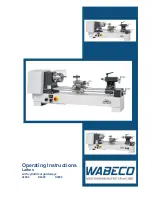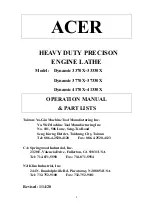
19
6. Assembly Instructions - cont.
Pulley Alignment
Correct pulley alignment is necessary in order to
minimise vibration. To check correct alignment
please follow the instructions below:
1. Ensuring the lathe is unplugged, remove the
cover plate (belt guard)
Fig 6.41
.
2. Rotate the thread protector by hand and
inspect the drive belt's position on the pulley to
ensure it is running true,
Fig 6.42
.
3. If the drive belt is not running true, remove
the locking grub screw,
Fig 6.43 A
, and dog
screw,
Fig 6.43 B
,
taking care to keep them in a
safe place, then slide the motor pulley along the
shaft until correct alignment is achieved.
4. When the pulley is correctly aligned, replace
the dog screw, ensuring it is located in the slot
on the shaft and tightened. Lock this in place
with the knurled screw on top.
Levelling the Lathe
It is important to level the lathe as accurately
as you can as an out of level lathe can affect
vibration and accurate alignment of headstock
and tailstock. Before finally tightening all parts
securely check and adjust for level as follows;
Place a spirit level across the two bed bars, at
each end of the lathe,
Fig.6.44
.
Bring the headstock and tailstock centres
together (with the drive centre and tailstock
centres fitted) and check for alignment of
the centres both vertically and horizontally,
Fig.6.45
.
If the centres do not line up correctly, or the
spirit level shows a different reading at each
end of the machine, it suggests that either the
bench top is uneven or the floor is not level,
which is causing the bench or stand to twist due
to the weight of the lathe. To correct this, you
should apply spacer shims on the underside of
the end brackets at the point of contact with
the surface bench or stand, at the appropriate
point. For example, if the spirit level shows that
the front bar is lower than the rear bar at one
end, a suitable shim should be placed under the
front edge of that end bracket in order to correct
the error. The type and thickness of the shim
will depend on the degree of distortion across
the bed of the lathe. Alternatively you can shim
underneath the feet of the bench or lathe stand.
When you are happy that the centres are
correctly aligned, then all fixings should be
fully tightened.
Fig.6.41
Fig.6.44
Fig.6.45
Fig.6.42
Drive belt
Thread
Protector
A
Knurled Base Grub Screw
which locates into the dog
grub screw.
B
Dog Grub Screw
Fig.6.43
Summary of Contents for CL3-CAM
Page 20: ...20 6 Assembly Instructions cont Fig 6 46 Fig 6 47 ...
Page 35: ...35 13 Spare Part Identification VSLK for CL4 CAM only ...
Page 46: ...46 ...
Page 47: ...47 ...










































